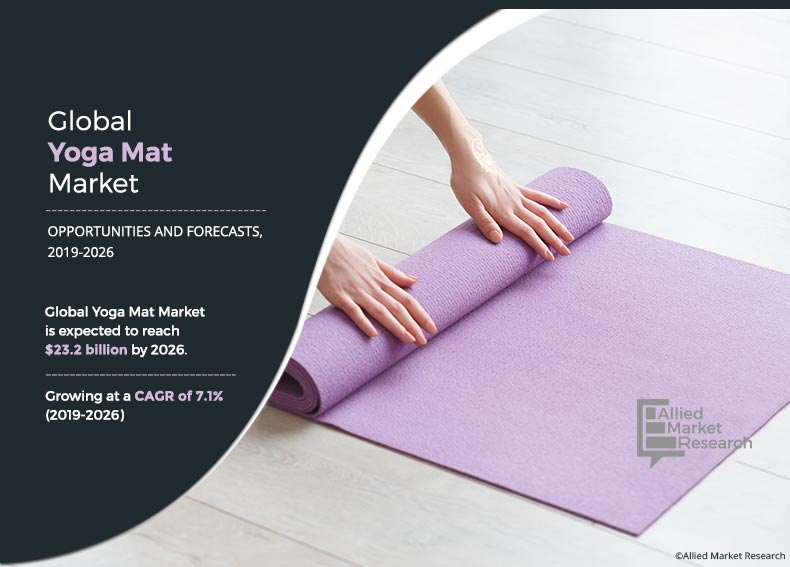
According to a new report published by Allied Market Research, titled, “Yoga mat Market by Material, End User, and Distribution Channel: Global Opportunity Analysis and Industry Forecast, 2018–2026,” The global yoga mat market size was at $13.3 billion in 2018, and is anticipated to reach $23.2 billion by 2026, with a CAGR of 7.1% during the forecast period. The market is expected to exhibit an incremental revenue opportunity of $9.9 billion from 2018 to 2026. Yoga has been practiced by more than 300 million practitioners globally. Yoga practice involves postures, exercises, and meditations, which are considered to be healthy for body and enhances peace of mind. Furthermore, yoga is practiced for benefits such as muscle toning & gaining stamina, flexibility, and strength. Thus, increase in number of yoga practitioners augments the yoga mat market demand , as they provide enhanced comfort in practicing various postures and exercises. Yoga mat is available in different materials, colors, and shapes, which further drives the growth of the market.
The yoga mat market growth is propelled by alarming surge in incidence of obesity and health-related diseases. In addition, consumers are increasingly following fitness practices such as yoga and are engaged in purchasing accessories for the same such as yoga mat, blocks, and yoga pants, which boost the growth of the global market. Furthermore, governments of various countries and yoga & fitness clubs have been actively engaged in promoting yoga worldwide, which has resulted in increased awareness of benefits of yoga globally. For instance, the Indian Prime Minister Narendra Modi proposed the idea of International Yoga Day at United Nations General Assembly (UNGA) in 2014. This encouraged people worldwide to practice and get involved in yoga and Pilates. Moreover, in 2016, the Indian Prime Minister asked his ministers to make Yoga a mass movement. All these factors collectively are anticipated to increase the number of yoga practitioners, which, in turn, will propel the demand for yoga mats, thereby driving the growth of the global market.
Request For Sample :- https://www.alliedmarketresearch.com/request-sample/6361
The yoga mat market is segmented into material, end user, distribution channel, and region. By material, the market is categorized into polyvinyl chloride (PVC), thermoplastic elastomers (TPE), rubber, cotton/jute, and others. Among these, PVC yoga mat are the most widely used among consumers, owing to their cost-effectiveness and easy availability in different sizes, shapes, and colors in all retail stores. The PVC segment was valued at $4.9 billion, and is expected to grow with a CAGR of 6.7% from 2019 to 2026, to reach $8.2 billion by 2026. However, the cotton/jute segment is estimated to grow at the highest rate during the forecast period, owing to rise in demand for yoga mats fabricated from biodegradable materials.
On the basis of end user, the households segment held a significant share in the global market in 2018. However, the yoga & fitness clubs segment is expected to grow at highest CAGR, owing to inclination of consumers toward joining professional yoga centers and fitness clubs coupled with increase in promotional campaigns by yoga & fitness clubs.
On the basis of distribution channel, the market is categorized into supermarket/hypermarket, specialty stores, e-commerce, and others. The specialty stores segment led the yoga mat market in 2018, and is estimated reach $12.2 billion, registering a CAGR of 6.8% during the forecast period. However, the e-commerce segment is anticipated to grow at the highest rate in the near future, owing to increase in penetration of smartphones and rise in number of consumers seeking for convenient lifestyle.
Get detailed COVID-19 impact analysis on the Yoga Mat Market Request Now ! https://www.alliedmarketresearch.com/request-for-customization/6361?reqfor=covid
Region wise, the yoga mat industry is analyzed across North America (U.S., Canada, and Mexico), Europe (Germany, France, UK, Italy, Spain, and Rest of Europe), Asia-Pacific (China, Japan, Australia, India, and Rest of Asia-Pacific), and LAMEA (the Middle East, Latin America, and Africa). Asia-Pacific led the market for yoga mat in 2018, due to rise in concern of consumers toward obesity and health in countries such as India, China, Japan, and Australia. By country, the U.S. serves as the potential market attributed to presence of largest number of yoga practitioners in the country.
Key Findings of the Study:
- By material, the cotton/jute segment is estimated to witness the fastest growth, registering a CAGR of 7.9% during the forecast period.
- Depending on end user, the household segment is expected to dominate the market for yoga mat, globally, holds 57.1% of share in the market.
- In 2018, by distribution channel, the specialty stores segment held the highest share, accounts 53.71% of the global yoga mat market share.
- In 2018, the U.S. was the most prominent market globally, and is expected to grow at a significant CAGR throughout the forecast period.
The key players profiled in the report on yoga mat market analysis include Manduka, Jade Fusion, prAna, Hugger Mugger, Adidas, Lululemon Athletica, Ecoyoga, Aurorae Yoga, LLC, Eupromed, and Yaazhtex.
Buy Now :- https://www.alliedmarketresearch.com/checkout-final/83617740e7515f53df9690bd47df4f27
David Correa
5933 NE Win Sivers Drive
#205, Portland, OR 97220
United States
USA/Canada (Toll Free):
+1-800-792-5285, +1-503-894-6022
UK: +44-845-528-1300
Hong Kong: +852-301-84916
India (Pune): +91-20-66346060
Fax: +1(855)550-5975
help@alliedmarketresearch.com
Web: www.alliedmarketresearch.com
Allied Market Research Blog: https://blog.alliedmarketresearch.com
Follow Us on | Facebook | Twitter | LinkedIn |